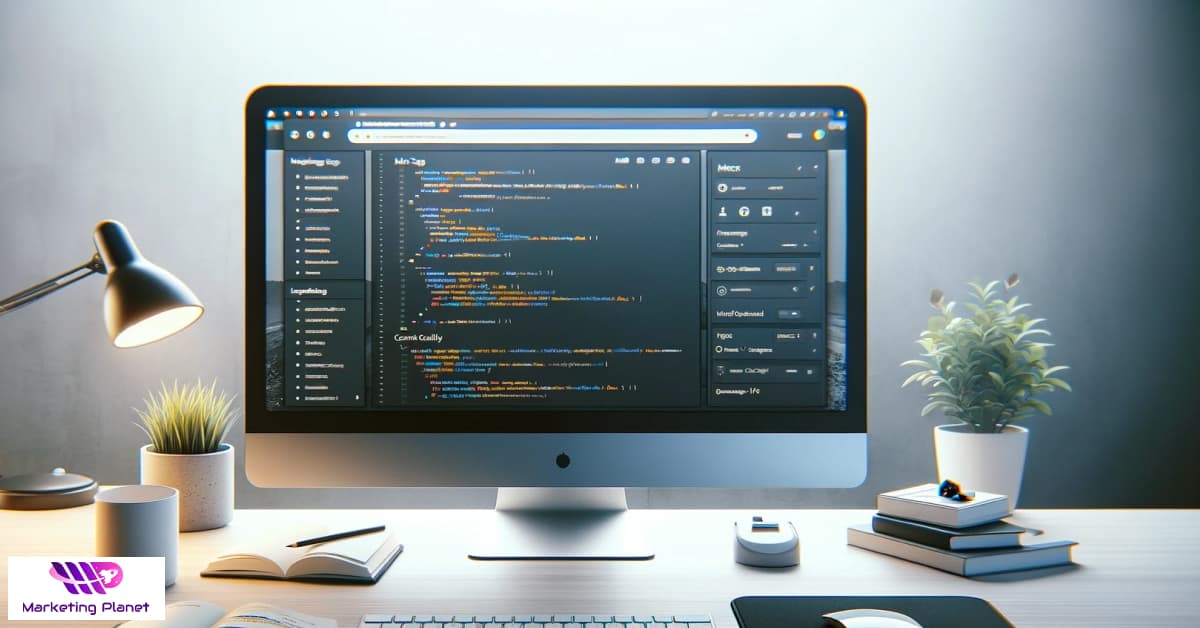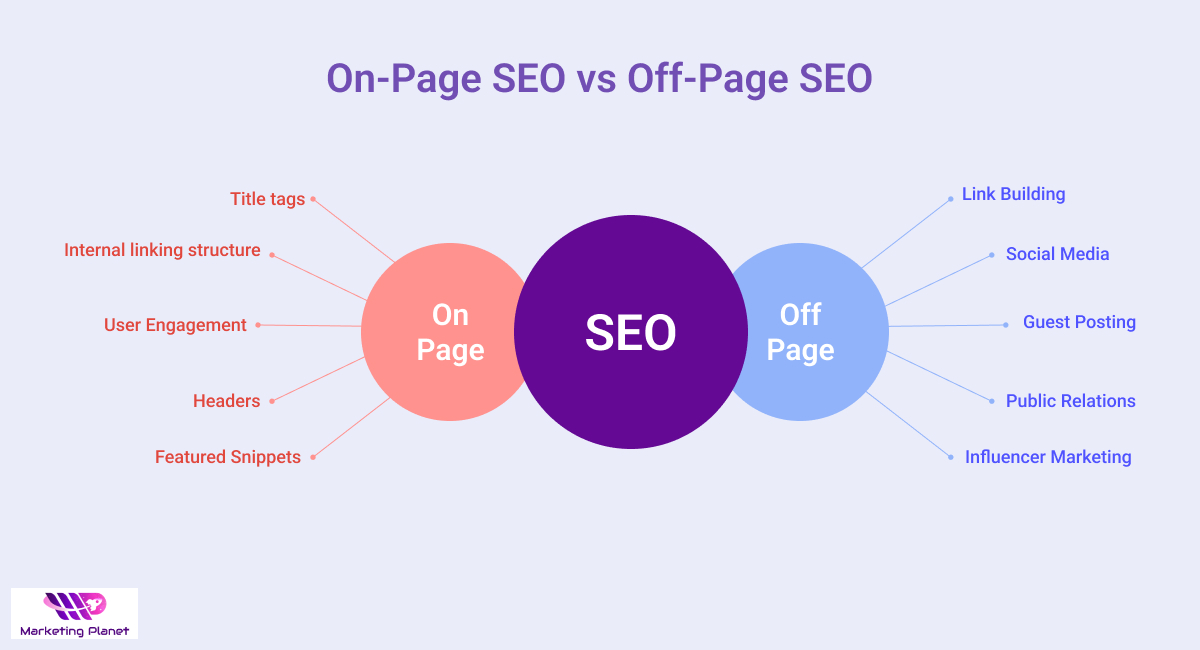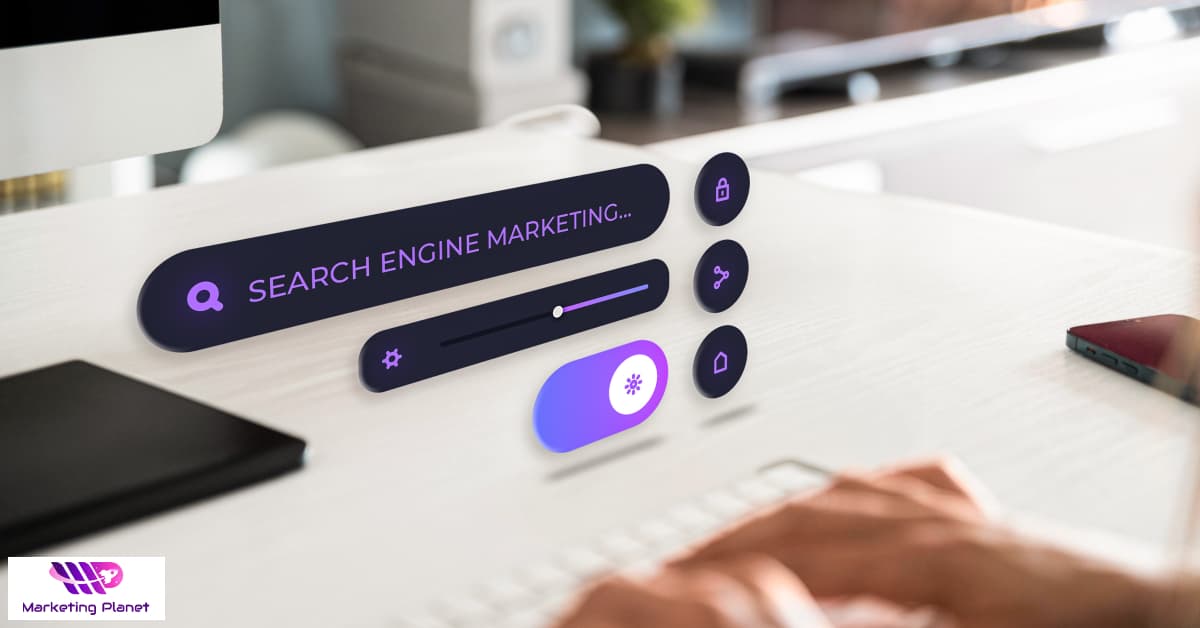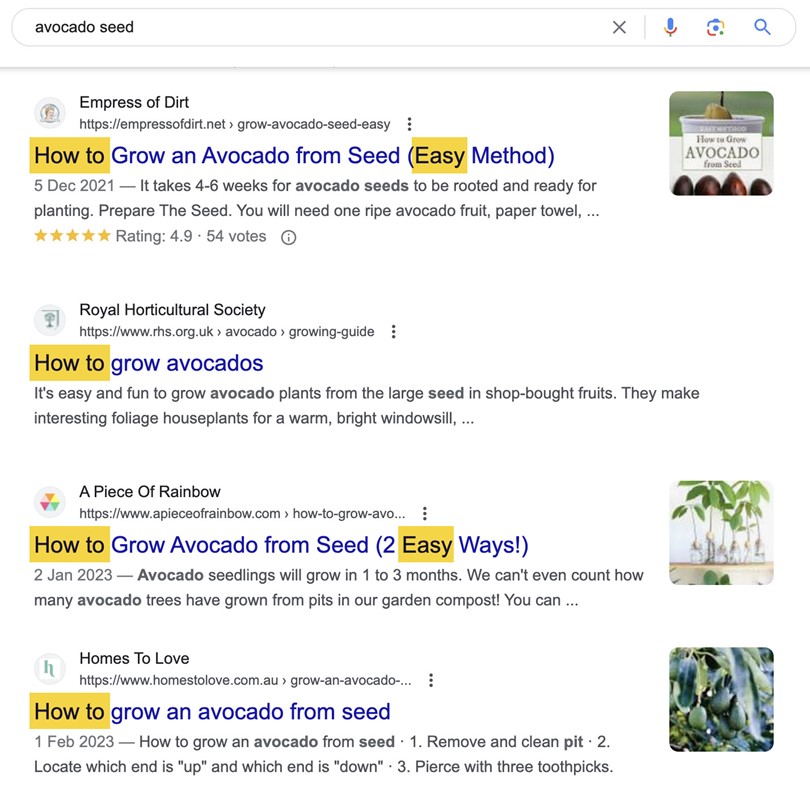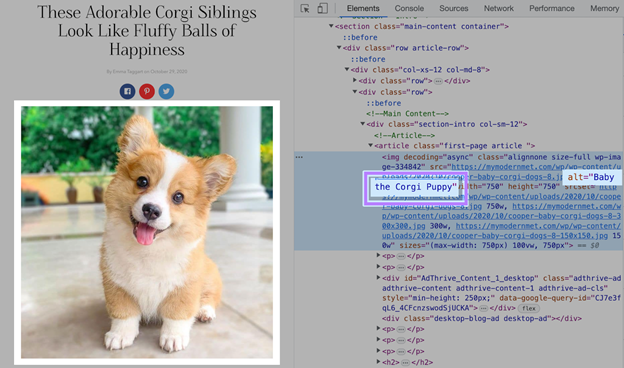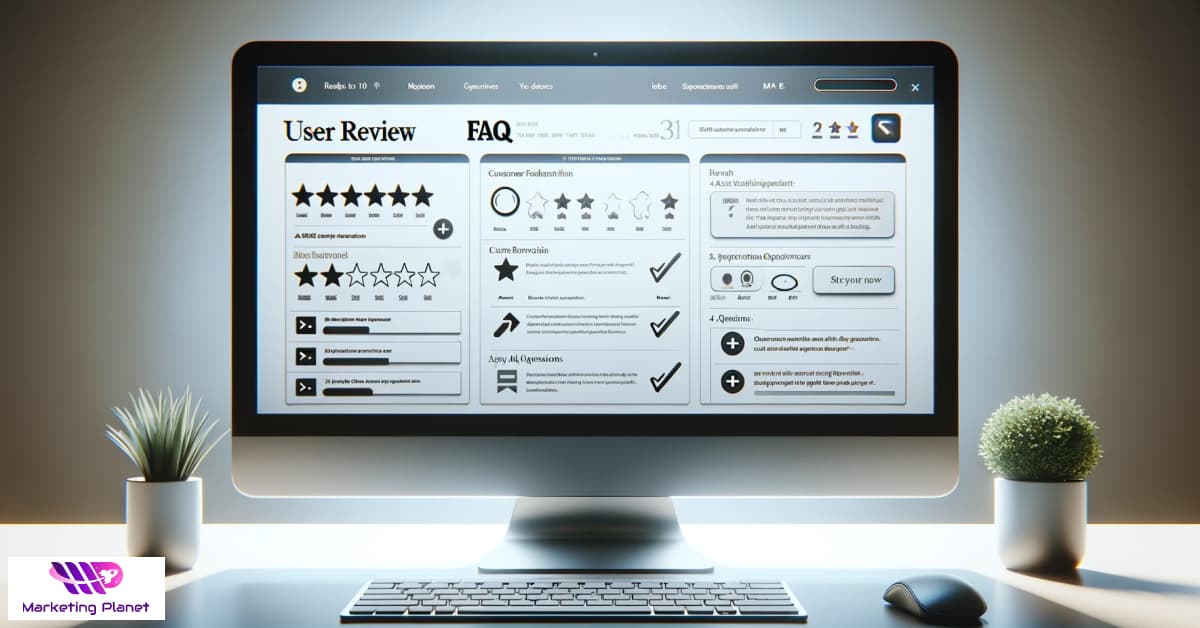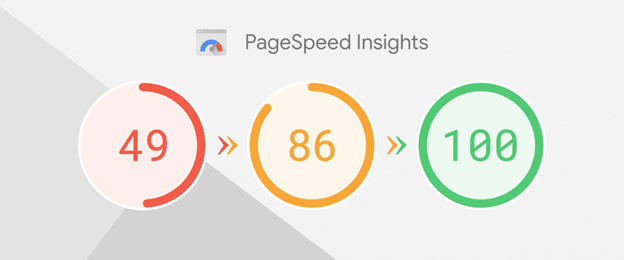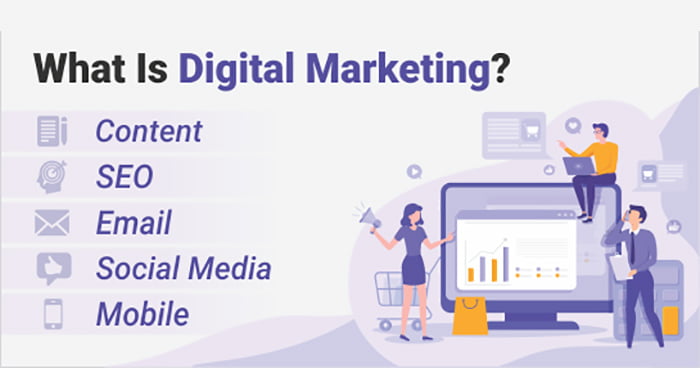Do you ever wonder how websites appear at the top of search results? It’s not magic, it’s SEO! But SEO is a broad term, and today, we’re diving into a crucial aspect: on-page SEO.
Table of Contents
ToggleIn this full guide, we’ll break down what on-page SEO is, why it matters, and how you can easily optimize your website to rank higher in search engines and attract more visitors.
Ready to take control of your website’s visibility? Let’s get started!
What Is On-Page SEO?
The process of optimizing webpages and their content for search engines and users is known as on-page SEO, or on-site SEO. It can increase a page’s Google ranking and increase organic traffic.
Optimizing for search intent, title tags, internal links, and URLs are common on-page SEO activities.
When it comes to climbing the ranks on Google, three main SEO areas come into play: on-page SEO, off-page SEO, and technical SEO. Think of them as working together to build a strong foundation for your website in the eyes of search engines.
- On-page SEO includes page elements for search engines to crawl and index a page.
- Off-page SEO includes social sharing and external linking.
- Technical SEO includes non-on-page elements like structured data, site speed, and mobile readiness.
Below, we’ll go over some methods for improving your website for on-page issues. But first, let’s analyze the distinction between on-page and off-page SEO.
On-Page SEO vs. Off-Page SEO
On-page and off-page SEO are two crucial parts of Search Engine Optimization (SEO) that work together to influence your website’s ranking in search results. Here’s a breakdown of the key differences:
On-Page SEO
- Focuses on optimizing elements within your website that you have control over.
- Involves making adjustments to your website’s content and structure to enhance its relevance for specific search terms.
Examples of on-page SEO practices include:
- Keyword research and incorporation
- Title tags
- Meta description optimization
- High-quality content creation
- Internal linking structure
- Mobile-friendliness and website speed
- Featured Snippets
- Headers
- Schema Mark-up
- User Engagement
- External linking
Off-Page SEO
- Focuses on building your website’s authority and credibility through external factors.
- Involves strategies to get other websites to link back to yours, essentially vouching for your content’s value.
- Earning backlinks is a significant aspect of off-page SEO. Backlinks from high-authority websites hold more weight with search engines.
Examples of off-page SEO practices include:
- Link Building
- Social Media
- Guest Posting
- Public Relations
- Influencer Marketing
- Local SEO
- Brand Mentions
Why Is On-Page SEO Important?
On-page SEO is a crucial tool for websites to communicate with Google, providing a friendly guide to visitors. It involves more than just incorporating keywords into HTML; it involves creating a welcoming environment for visitors to find what they’re looking for.
To rank content in 2024, it’s essential to optimize user experience, bounce rate and dwell time, search intent, page loading speed, and click-through-rate. In essence, on-page SEO is not just a checklist; it’s a secret weapon for attracting attention and making your website stand out.
In general, on-page SEO is important for several reasons:
- It helps search engines understand your website’s content and relevance to search queries, increasing your chances of ranking higher on search results pages.
- Effective on-page SEO attracts users who are genuinely interested in your offerings by incorporating relevant keywords and crafting informative content.
- It also enhances the user experience by optimizing page load speed, using clear titles, and structuring content logically.
- Off-page SEO, which focuses on external factors, is significantly boosted by a well-optimized website with strong on-page SEO.
- Consistently implementing good on-page SEO practices builds trust with search engines and users, contributing to your website’s credibility and brand value.
How to Do On-Page SEO?
Contrary to popular belief, on-page SEO does not include simply repeating keywords throughout a page. You will really lower your ranks if you do this too often. Let us now go over several sensible optimizations that will have a positive effect.
1- Write Unique and Valuable SEO Content
When we say “Unique”, we are not just talking about duplicate content. We mean, instead of just copying what others have already said, you want your content to stand out. It should offer something fresh and interesting, like:
- A brand new tip or trick nobody else has mentioned.
- A super helpful list of resources all collected in one place.
- A design that’s easy and enjoyable to use.
- A real-life example (like a story) that shows your idea in action.
- A clear and simple guide that makes things easy to understand.
Publishing something that’s unique is good. But it’s not enough. Here are some ideas for turning your SEO content into something incredibly valuable:
- It’s simple for someone to implement your content if it includes screenshots, instructions, and images.
- Strong copywriting will increase reader engagement.
- Fresh ideas, techniques, and examples are very helpful.
- The authors of most content have never actually done the thing they are advising you to do. First-hand experience-based content is nearly always more useful than that of a random freelance writer.
- Give your readers accurate, up-to-date information.
2- Consider Search Intent
Search intent is the primary reason for a user’s search, providing insight into what users are seeking and the content they need to deliver.
To identify search intent, analyze top-ranking results on Google and identify the three Cs: content type, content format, and content angle.
Content type refers to the dominant type of content, such as blog posts, product pages, or videos.
Content format includes how-to guides, list posts, reviews, and comparisons.
Content angle provides insight into what searchers value in a search. For instance, top-ranking pages for “avocado seed” are blog posts with “easy” and “simple” angles, indicating beginners seeking straightforward advice.
3- Use Click-worthy Titles
The title tag page titles (also known as page title) is a crucial on-page SEO factor, providing search engines with a high-level overview of your page’s content. The closer the keyword is to the beginning of the title tag, the more it gains weight with search engines.
To optimize site page ranking, include the focus keyword in the title and ensure it is incorporated naturally.
Here are some tips:
- To prevent truncation, keep them under 70 characters.
- Inform searchers that you have what they’re looking for by matching search intent.
- Don’t be vague or generic; instead, be specific.
- Avoid clickbait by ensuring that they are relevant to your content.
- Add the keyword and, if a close variation makes more sense, use it.
- Add the year if the topic requires freshness.
4- Write Unique Meta Descriptions
While meta descriptions don’t directly affect your Google ranking], they can be like a neon sign, grabbing attention and pulling in more visitors. Why? Because Google frequently uses them as those bite-sized summaries you see under website titles in search results. Here’s how to craft descriptions that shine:
- Keep it concise: Aim for under 160 characters to avoid getting cut off in the search results.
- Expand on your title: Mention unique selling points (USPs) you couldn’t squeeze into the title tag.
- Match search intent: Double down on what searchers are looking for.
- Speak directly: Use an active voice to grab their attention.
- Include your keyword: Include your target keyword – Google often bolds it to make it stand out.
5- Use Headings and Subheadings
Headers, also known as body tags, refer to the HTML element <h1>, <h2>, <h3>, and so on. Tags aid in content organization and help search engines determine the most important and relevant content based on search intent.
Here is why using headings and subheadings improves your on-page SEO:
- Headings and subheadings are essential for on-page SEO and user experience (UX).
- They enhance readability and scannability by breaking up content, making it easier for users to find information quickly.
- They also enhance content structure by establishing a clear hierarchy, demonstrating how different sections relate to each other and the overall topic.
- Search engines use headings to understand key points and the context of content, and by strategically including relevant keywords in headings and subheadings, you can signal to them what your page is about and improve your ranking for those terms.
6- Optimize Keywords
Use Your Target Keyword In The First 100 Words
Including your main keyword early in your content remains a valuable SEO practice. It helps search engines grasp the topic from the outset. All you need to do is use your main keyword once in the first 100-150 words of your article.
Include Your Keywords Into Headings
Heading tags are crucial in content creation, guiding search engines and users through webpages. Google states that using an H1 tag helps understand page structure. It’s best to include a single H1 per page and ensure your title is wrapped in an H1 and your keyword is inside.
Incorporating target keywords within H1 to H6 tags communicates topical relevance to search engines and enhances user experience by providing a clear hierarchy. While heading tags don’t necessarily impact on-page SEO, they can help improve the user experience.
Experiments have shown that wrapping target keywords in an H2 tag can make a difference.
Keyword Frequency
Keyword frequency refers to the number of times a keyword appears in a content. While Google may deny that using the same keyword multiple times is beneficial, experienced SEO professionals believe it is.
Imagine a page with a specific keyword appearing only once on it. Google’s confidence in a page’s topic is not very high, but if the page mentions the keyword 10 times, it can increase its confidence.
This is not about keyword stuffing, but simply mentioning the target keyword a few times to confirm the page’s relevance to the topic.
Key places to include your keywords on your page include:
- Title Tags and Meta Description
- Alt Text
- URLs
- Headings
- First Paragraph
7- Optimize URLs
Google advises using simple URLs that are relevant to your content, not cryptic or intimidating. Avoid random numbers, publish dates or full sentences.
Website themes often use these by default, so update your URL before publishing. Using your target keyword in your URL ensures it matches the content’s topic.
8- Add Internal and External Links
Internal links are hyperlinks that point to different pages on the same website. They are crucial for on-page SEO optimization as they help search engines understand the site’s structure, enable Google crawlers to discover new pages, signal to Google that the linked-to page is valuable, and help users navigate the website, thereby retaining them longer.
External links on your site enhance user experience and build trust with your audience. Google recommends adding links to authoritative external sources for value.
To ensure a solid user experience, follow best practices: link to trustworthy sites related to the topic and niche, use descriptive anchor text to guide readers, and balance the number and placement of external links to avoid spamming.
9- Use and Optimize Visual Assets
Adding pictures, videos, and infographics to your page does more for you than just make it seem good. It also provides you with chances to improve your SEO.
When purchasing online, over 36% of consumers utilize visual search; therefore if you’re not using photos, you’re losing out on traffic.
Optimizing images involves writing descriptive alt text, which is text in HTML code that describes an image on a webpage.
It provides context for search engine crawlers and allows screen readers to hear descriptions. To write good alt text, keep it brief, include a target keyword for context, and avoid adding it to decorative images like horizontal page breaks or magnifying glasses.
Avoid using phrases like “image of” or “picture of,” as they suggest describing an image and don’t need to be wasted characters. This helps ensure that images are easily readable and search engine friendly.
10- Use Review or FAQ
Reviews and FAQs are valuable tools for on-page SEO. Reviews can indirectly improve SEO ranking by increasing user engagement and building trust and credibility. They also provide valuable user-generated content, which is a positive SEO signal.
FAQs, on the other hand, can target long-tail keywords, improving user experience and reducing bounce rates. They can also increase dwell time by keeping users on the site longer as they find answers to their questions.
Structured FAQ sections can also increase the chances of appearing in a featured snippet, a top search result with a short answer. Both strategies contribute to a website’s overall SEO performance.
11- Check Mobile Responsiveness
Google now favors sites optimized for faster mobile speeds, even for desktop searches. Mobile responsiveness is crucial, and choosing a suitable hosting service, site design, theme, and content layout is essential. To assess your site’s mobile readiness, use Google’s Mobile-Friendly Test tool.
12- Boost Page Speed
Page loading speed is a crucial SEO ranking signal, and improving it can be achieved by moving to a faster host, removing third-party scripts, and focusing on factors that impact full loading fully loaded on desktop and mobile.
If these strategies don’t yield the desired results, it’s essential to delve deeper into the site’s technical aspects.
Tools like Google PageSpeed Insights can identify specific issues affecting page speed, allowing for individual solutions. Enhancing page speed is not just a best practice; it’s a pivotal step in ensuring your website meets evolving on-page standards set by search engines.
Conclusion
On-page SEO is the cornerstone of any effective search engine optimization strategy. By optimizing your website’s content, structure, and technical elements, you can signal to search engines that your pages are relevant and valuable to user search intent. This, in turn, can lead to higher rankings in search results pages and increased organic traffic.
Remember, on-page SEO is an ongoing process. Search engine algorithms are constantly evolving, and user preferences change over time. Stay up-to-date on the latest best practices, and regularly monitor your website’s performance to ensure you’re getting the most out of your on-page SEO efforts.
For an extra boost, consider combining your on-page SEO strategy with off-page SEO tactics like link building and social media promotion. By taking a comprehensive approach, you can create a website that thrives in the dynamic world of search.

